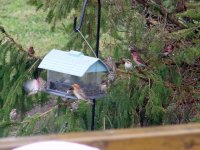Hi Forum,
I just found out tonight that I got a photo of this bird the other day at my feeders. He was hanging out with all the purple finches but this one is obviously more orange. I don't think he's a crossbill... he's too finch-like. Could he be a purple finch with messed up pigmentation? I know it's not the best quality shot but like I said, I didn't even know I had this much!
Any ideas??
I just found out tonight that I got a photo of this bird the other day at my feeders. He was hanging out with all the purple finches but this one is obviously more orange. I don't think he's a crossbill... he's too finch-like. Could he be a purple finch with messed up pigmentation? I know it's not the best quality shot but like I said, I didn't even know I had this much!
Any ideas??





